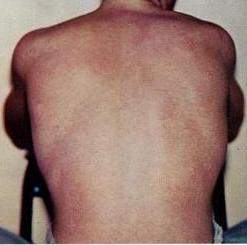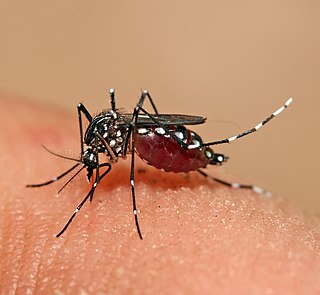
Dengue fever is a mosquito-borne disease caused by dengue virus, prevalent in tropical and subtropical areas. It is frequently asymptomatic; if symptoms appear they typically begin 3 to 14 days after infection. These may include a high fever, headache, vomiting, muscle and joint pains, and a characteristic skin itching and skin rash. Recovery generally takes two to seven days. In a small proportion of cases, the disease develops into severe dengue with bleeding, low levels of blood platelets, blood plasma leakage, and dangerously low blood pressure.

Aedes albopictus, from the mosquito (Culicidae) family, also known as the (Asian) tiger mosquito or forest mosquito, is a mosquito native to the tropical and subtropical areas of Southeast Asia. In the past few centuries, however, this species has spread to many countries through the transport of goods and international travel. It is characterized by the white bands on its legs and body.

Aedes is a genus of mosquitoes originally found in tropical and subtropical zones, but now found on all continents except Antarctica. Some species have been spread by human activity: Aedes albopictus, a particularly invasive species, was spread to the Americas, including the United States, in the 1980s, by the used-tire trade.

Wolbachia is a genus of gram-negative bacteria that can either infect many species of arthropod as an intracellular parasite, or act as a mutualistic microbe in filarial nematodes. It is one of the most common parasitic microbes of arthropods, and is possibly the most common reproductive parasite in the biosphere. Its interactions with its hosts are often complex. Some host species cannot reproduce, or even survive, without Wolbachia colonisation. One study concluded that more than 16% of neotropical insect species carry bacteria of this genus, and as many as 25 to 70% of all insect species are estimated to be potential hosts.

Dengue virus (DENV) is the cause of dengue fever. It is a mosquito-borne, single positive-stranded RNA virus of the family Flaviviridae; genus Flavivirus. Four serotypes of the virus have been found, and a reported fifth has yet to be confirmed, all of which can cause the full spectrum of disease. Nevertheless, scientists' understanding of dengue virus may be simplistic as, rather than distinct antigenic groups, a continuum appears to exist. This same study identified 47 strains of dengue virus. Additionally, coinfection with and lack of rapid tests for Zika virus and chikungunya complicate matters in real-world infections.

Aedes aegypti, the yellow fever mosquito, is a mosquito that can spread dengue fever, chikungunya, Zika fever, Mayaro and yellow fever viruses, and other disease agents. The mosquito can be recognized by black and white markings on its legs and a marking in the form of a lyre on the upper surface of its thorax. This mosquito originated in Africa, but is now found in tropical, subtropical and temperate regions throughout the world.
Stegomyia is a large subgenus of the mosquito genus Aedes with 131 species classified in six species groups, two groups of which are further divided into subgroups.
In the 2005 dengue outbreak in Singapore, a significant rise in the number of dengue fever cases was reported in Singapore, becoming the country's worst health crisis since the 2003 SARS epidemic. In October 2005, there were signs that the dengue fever outbreak had peaked, as the number of weekly cases had declined and the outbreak of this infectious disease declined by the end of 2005.
The 2006 dengue outbreak in Pakistan was at the time the worst on record. There were 1931 lab-confirmed cases, and 41 confirmed deaths, according to the World Health Organization Regional Office for the Eastern Mediterranean. Other sources report a death toll of 52.

Mosquito-borne diseases or mosquito-borne illnesses are diseases caused by bacteria, viruses or parasites transmitted by mosquitoes. Nearly 700 million people contract mosquito-borne illnesses each year, resulting in more than a million deaths.

Zika virus is a member of the virus family Flaviviridae. It is spread by daytime-active Aedes mosquitoes, such as A. aegypti and A. albopictus. Its name comes from the Ziika Forest of Uganda, where the virus was first isolated in 1947. Zika virus shares a genus with the dengue, yellow fever, Japanese encephalitis, and West Nile viruses. Since the 1950s, it has been known to occur within a narrow equatorial belt from Africa to Asia. From 2007 to 2016, the virus spread eastward, across the Pacific Ocean to the Americas, leading to the 2015–2016 Zika virus epidemic.
Aedes polynesiensis, the Polynesian tiger mosquito, is only found in the South Pacific on the islands of Austral Islands, Cook Islands, Ellice Islands, Fiji Islands, Hoorn Islands, Marquesas Islands, Pitcairn Island, Samoa Islands, Society Islands, Tokelau Islands, Tuamotu Archipelago. It is a vector of dengue, Ross River virus, and lymphatic filariasis, and a probable vector of Zika virus. Adults lay eggs in natural and human-associated pools of freshwater. Common larval habitats include tree holes, holes in volcanic rock formations, coconut shells, water storage containers (drums), and discarded trash.

The 2007 Yap Islands Zika virus outbreak represented the first time Zika virus had been detected outside Africa and Asia. It occurred in the Yap Islands, an island chain in the Federated States of Micronesia. Zika virus (ZIKV) is a vector-borne flavivirus in the same family as yellow fever, dengue, West Nile and Japanese encephalitis viruses.

A lethal ovitrap is a device which attracts gravid female container-breeding mosquitoes and kills them. The traps halt the insect's life cycle by killing adult insects and stopping reproduction. The original use of ovitraps was to monitor the spread and density of Aedes and other container-breeding mosquito populations by collecting eggs which could be counted, or hatched to identify the types of insects. Since its conception, researchers found that adding lethal substances to the ovitraps could control the populations of these targeted species. These traps are called lethal ovitraps. They primarily target Aedes aegypti and Aedes albopictus mosquitoes, which are the main vectors of dengue fever, Zika virus, west Nile virus, yellow fever, and chikungunya.

An epidemic of Zika fever, caused by Zika virus, began in Brazil and affected other countries in the Americas from April 2015 to November 2016. The World Health Organization (WHO) declared the end of the epidemic in November 2016, but noted that the virus still represents "a highly significant and long term problem". It is estimated that 1.5 million people were infected by Zika virus in Brazil, with over 3,500 cases of infant microcephaly reported between October 2015 and January 2016. The epidemic also affected other parts of South and North America, as well as several islands in the Pacific.
Aedes hensilli is a mosquito species originally collected in 1945 on Ulithi atoll in the Caroline Islands of the western Pacific Ocean, about 191 km east of Yap State. It is the most abundant and widespread Aedes (Stegomyia) species mosquito in Yap State, the only Aedes (Stegomyia) species on Woleai, and the only species of mosquito present on Eauripik.
Aedes malayensis was first described in 1963 by Australian entomologist Donald Henry Colless as a subspecies of Aedes scutellaris from males collected at Pulau Hantu, Keppel Harbor, Singapore. In 1972 the subspecies was elevated to species status by Yiau-Min Huang, although the move was disputed by the original describer on biological as opposed to morphological principles.
Aedes mediovittatus, the "Caribbean treehole mosquito," was first described in 1906 as Stegomyia mediovittata by Daniel W. Coquillett.
Aedes (Downsiomyia) albolateralis is a species of zoophilic mosquito belonging to the genus Aedes. It is a member in Aedes niveus subgroup. It is found in Sri Lanka, Indonesia, Malaysia, Thailand, Andaman Islands, China, India, Borneo and Singapore. It is highly susceptible to nocturnally subperiodic Wuchereria bancrofti and dengue type 2 virus. Virus could replicate in salivary gland, cervical cell of brain and fat body cells but not in gut and ovary.
In the 2020 dengue outbreak in Singapore, a record-breaking number of dengue fever cases was reported in Singapore. This was part of the wider 2019–2020 dengue fever epidemic which also affected several neighbouring countries in Southeast Asia.









